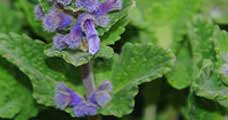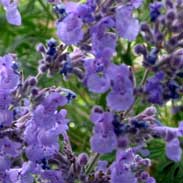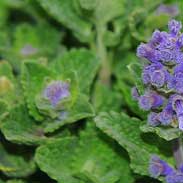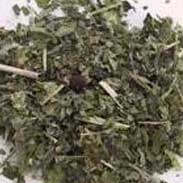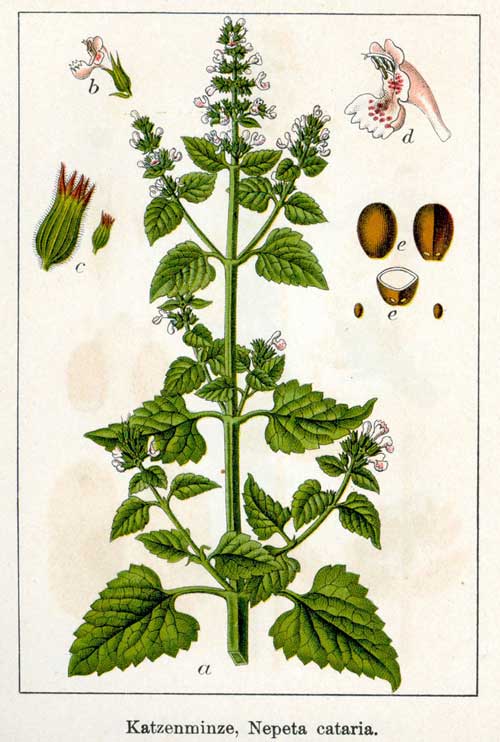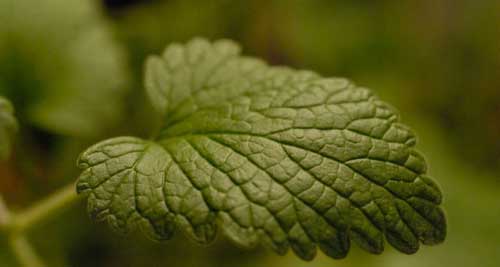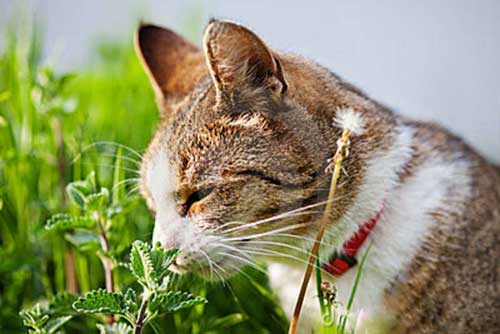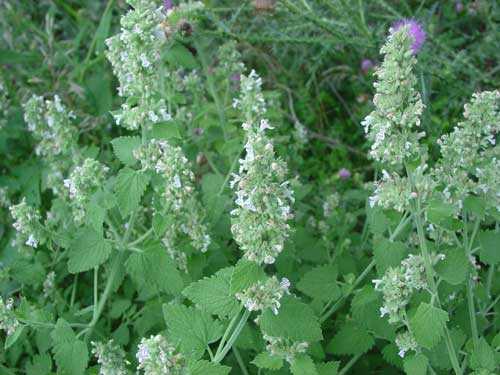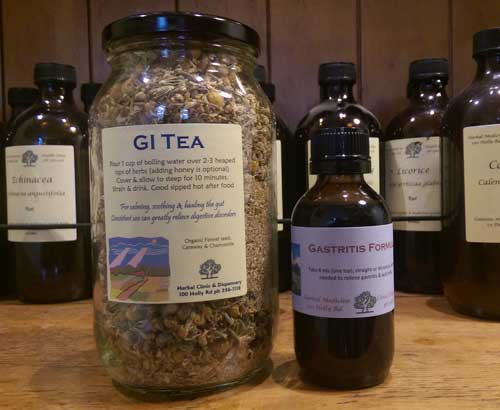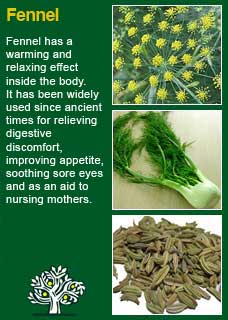
|
|
||||
| Our Pages ABOUT CONSTITUTIONAL MEDICINE
|
The leaves of Catnip, or Catmint, a herb with a minty odour and a pleasant taste. Catnip plants (Nepeta cataria and other Nepeta species) are members of the mint family and the plant is popular in herb gardens and grows widely as a weed. If Catmint is unmolested by felines it will grow erect to nearly a meter with greenish-white serrated leaves with furry undersides.
T. Bartram says 'Catnip makes cats frolicsome, amorous and full of fun’ and it has surely long been observed that the plant has a powerful impact on our feline friends causing them to 'roll upon, chew, and tear to bits any withered leaf until nothing remains' In fact, Catnip has been used medicinally from Europe to China for at least 2000 years. Old herbals praised its ability to promote sweating help cure fevers and it was considered a cough and cold remedy and a herb to relieve chest congestion and phlegm. Catnip was very popular in England in beverages up until Elizabethan times when it was largely replaced by the more stimulating herb that we now all call 'tea' (Camellia sinensis) David Hoffmann says, 'it is a perfect remedy for the treatment of diarrhoea in children' and says it is 'a valuable diaphoretic, helpful in any feverish condition, especially acute bronchitis' The great 20th century physiomedicalist T. J Lyle writes that is is good for children's colic, restlessness, nervous irritability and fevers and says 'in hot infusion it influences the circulation, soothes the nervous system and relieves irritation, and under proper conditions, it increases both menstrual and renal flows. The addition of Zingiber (Ginger) increases diaphoresis and intensifies all the influences of Nepeta' W Cook wrote 'the profession generally overlook its virtues in such connections, but it is a diffusive nervine and antispasmodic of much service' He suggests that 'combined with equal quantities of extracts of Aniseed and Valerian, it makes a nervine and antispasmodic preparation of the highest value' Cook also counsels against making an infusion of Nepeta with water that is too hot as it makes the tea too bitter and loses its relaxant, carminative properties, he says it is 'best made by digesting the herb for ten minutes in water much below the boiling heat, and then straining' From King's Dispensatory, 1898: 'Catnip is diaphoretic and carminative in warm infusion and tonic when cold. It is also antispasmodic, emmenagogue, and diuretic. In warm infusion Catnip is used in febrile diseases as a diaphoretic, and to promote the action of other diaphoretics, as well as to allay spasmodic action and produce sleep; it is also given as a carminative and antispasmodic in the flatulent colic of children; and as an emmenagogue or uterine tonic. It has proved decidedly beneficial in amenorrhoea and dysmenorrhoea, and has likewise been successfully employed in nervous headache, hysteria, and nervous irritability' Mary Bove, in her Encyclopaedia of Natural Healing for Children writes 'it is a favourite choice for colicky babies when mixed with Fennel seed and used as a tea to relieve pain and move gas along' She says, 'think of Catnip for any digestive complaints associated with nervousness, stress or anxiety' Catnip has long been used for childhood infections, fevers, aches and pains, bad-tempered moods, sleeplessness and digestive upsets. Once upon a time, it was even recommended as a front-line treatment against the dreaded fever of smallpox.
~ German researchers report that the nepetalactone isomers that make Catnip so intoxicating for cats are similar to the natural sedatives in Valerian (the valepotriates), supporting Catmint's traditional use as a gentle relaxant. ~ An extract of catnip (Nepeta cataria) was studied for the effects of subminimum inhibitory concentrations on enzyme production in S. aureus 6538P and 44 strains of Staphylococcus aureus, some of which were resistant to methicillin. Concentrations equal to ½ and ¼ MIC inhibited DNAse, thermonuclease, and lipase, and reduced adherence in vitro (Nostro, A., Cannatelli, M. A., Crisafi, G., and Alonzo, V. The effect of Nepeta cataria extract on adherence and enzyme production of Staphylococcus aureus. Int.J.Antimicrob.Agents 2001;18(6):583-585) ~ Preliminary research shows that catnip has relaxant, sleep inducing effects (Harney, J. W., Barofsky, I. M., and Leary, J. D. Behavioral and toxicological studies of cyclopentanoid monoterpenes from Nepeta cataria. Lloydia. 1978;41(4):367-374) and also (Massoco, C. O., Silva, M. R., Gorniak, S. L., Spinosa, M. S., and Bernardi, M. M. Behavioral effects of acute and long-term administration of catnip (Nepeta cataria. Vet.Hum.Toxicol 1995;37(6):530-533) Jackson et al. have discussed the potential effect of catnip on the alteration of consciousness (Jackson, B. and Reed, A. Catnip and the alteration of consciousness. JAMA 2-17-1969;207(7):1349-1350) ~ Further information at the end on some science on how Catnip works on cats and the authors, titles and the 'where-and-when' published of about 20 further studies and articles on Catnip are listed in a PDF found here There have been concerns raised about its safety in pregnancy, one reference saying that 'Catnip tea is said to have uterine stimulant properties' McGuffin M, Hobbs C, Upton R, Goldberg A, eds. Boca Raton, FL: CRC Press, LLC 1997. However, it should be borne in mind that this and other cautions in pregnancy have come about because of it being historically recommended to help with problems in menstruation, as quoted in Lyle above, or by WM Cook who says 'it promotes menstruation moderately in acute cases and relieves dysmenorrhea'. That it may have such an action is no reason to think it would ever be harmful in pregnancy and it has certainly never accumulated such concerns despite extensive use throughout history, but there it is. If a pregnant woman was using it and wanted to continue, I would not be at all worried about it if the levels were in the kinds of doses as described below. Hoffmann simply writes 'no side effects or drug interactions have been reported'.
For some years now, against this proven and safe way of herbalism, there has been a rising tide of excessive caution and scare-mongering in many parts of the world. The same authorities that, not so long ago, decried herbal medicines as ineffectual, have now taken up a different adversarial position; that they are dangerous substances that should only be prescribed by Doctors, who of course have zero training in them. Unfortunately, the same unnecessary fear and worry has crept into many natural health websites and popular publications on herbs. Herbs that we have safely used for thousands of years, that have no reports of adverse reactions in the medical literature despite widespread use by millions of people, are suddenly described as contraindicated because of something that should have been seen as completely unimportant, or at the utmost a merely theoretical concern, such as a laboratory study on one of the herb's constituents to use an all too common example. I wonder sometimes if the writers of such articles feel that the herb will be more deserving of respect if it is thought to be a little bit dangerous, in other words more like a drug than something that has simply come out of the earth and been used by ordinary people for generations beyond count. There is just so much misinformation about herbal medicine on the internet now. Ludicrous claims and cautions abound in equal measure; it seems like one group are trying to make money out of the public whilst the other are busily trying to scare them off. I have to believe that the kind of reader who takes the time to read pages on herbs that are as extensive as this one is much less likely to be swayed by marketers or misinformers. I hope that you will keep your wits about you if you get conflicting opinions from people who have never really got to know these herbs, who have never worked with them, or learned how to use them safely and effectively. I want to remind you that the reason that herbs can never be patented and owned by any individual or corporation is because they are, and always will be, the People's medicine. They belong to all of us and it is my great hope in sharing this work that you will learn how to use them wisely for yourself, and the people you care for. Be safe, but do not be afraid.
by Ramona Turner, a veterinarian specializing in feline care for 25 years Cats, from our domestic companions to lions and tigers, are exquisitely susceptible to a volatile oil found in the stems and leaves of the catnip plant. When cats smell catnip they exhibit several behaviors common to queens in season (females in heat): They may rub their heads and body on the herb or jump, roll around, vocalize and salivate. This response lasts for about 10 minutes, after which the cat becomes temporarily immune to catnip's effects for roughly 30 minutes. Response to catnip is hereditary; about 70 to 80 percent of cats exhibit this behavior in the plant's presence. In addition, catnip does not affect kittens until they are about six months old and begin to reach sexual maturity. Catnip is considered to be nonaddictive and completely harmless to cats
The amygdala integrates the information flow from the olfactory bulb cells and projects to areas governing behavior responses. The hypothalamus regulates neuroendocrine responses through the pituitary gland, creating a "sexual response." That is, the cat essentially reacts to an artificial cat pheromone.
Catnip is a surprisingly powerful herb to work with in clinical practice. Like other members of the mint family it has this marvellous quality of being quite humble looking, and of course it is terribly common, but then it packs an enormous therapeutic punch when you give it to the right person at the right time. Considering such historical uses as the deadly smallpox fever you can be sure that this was not always relegated to a curious herb for cats or a mild digestive tonic for children. I have seen in practice how it can produce a profuse sweat and so greatly allay the pain and misery that the body was enduring in its unaided efforts to mount a therapeutic fever. Catnip is a lovely herb to give to children who are miserable with any kind of cold, flu or fever. It is gentle tasting, easy on the stomach and highly effective at helping to move the healing process along. For a child, just one tsp of Catnip is strong enough to convey the medicinal benefit, best steeped in about half a cup of recently boiled water for 10 minutes then strained and drunk. it is good to add some honey if this food is available and allowed. For adults in the throes of a ghastly flu I would use 2 or 3 times the above dose but a key use of Catnip in my older patients has been modest doses, e.g. just 2 grams or so, in tea formulae that are taken over several weeks where I have found that a small amount can greatly help with the tea being easily absorbed by those who have a sensitive stomach. Likewise, as a remedy in its own right, I am certain that Catnip makes a good difference to those who suffer from nervous stomachs and painful tight conditions such as indigestion, griping, or cramping pains in the soft tissues. If you who are reading this have some Catnip growing or can get some of its dried herb then I warmly recommend you try drinking a cup of its tea sometime to feel how gentle and soothing it is on your whole system. My number one use of Catnip over the years has been in a tonic called 'Gastritis Formula' that we use for people with heart-burn, indigestion and gastro-oesophageal reflux disease (GORD). It is shown in more detail below. It is excellent to use in a tea form combined with other herbs for children who are struggling with colds, flu, fevers, gastro infections, and general agitation and restlessness. An example of a restless children's tea is also shown below. A heaped tsp of Catnip, steeped for 10 minutes in water that has cooled down a few degrees after being boiled, will convey all the medicinal properties of the herb. We make a robust 1:5 tincture in 40% ethanol that only needs 2 mls or so in a dose to give the nervine, relaxant, calming digestive properties. I personally believe that, whilst larger amounts could be safely used and are recommended by some authors, that this is one of many herbs where 'less is more' and that the optimal amount is that which the body can feel and respond to without there being further benefit from trying to force the issue, so to speak.
Gastritis, reflux, heartburn, indigestion, whatever name you call it, has been successfully treated by herbalists for many thousands of years with simple, easy to obtain, remedies. . One in particular has given such consistently good results that it can be broadly recommended to anyone who has need of it, we call it Gastritis Formula, and it is made as follows:
Dosage is vital to the success of all herbal medicines. The Gastritis formula must be taken on an 'as needed' basis, meaning you take it as freely and frequently as required until the symptoms are resolved, and the condition is cured. As soon as you start getting symptoms of indigestion, reflux, gastritis etc. take approximately 4-5 mls of the formula either straight or mixed with just a few mls of water. The medicine will start working immediately but will take up to 20 minutes to get the full effect. If things settle down and improve from just the one dose then great, put it aside and wait until you need it again. However, if the relief is only slight or temporary, you should keep taking doses, at least 20 minutes apart, until the condition has greatly improved. You can safely take up to 8 doses in a day for at least a few days if things are very bad. If you have a bad condition, or perhaps if you are coming off some form of stomach acid blocking drug, you may need to use a lot of the formula for a few days and this may mean that you end up taking quite significant levels of Licorice root over a short time-frame. For some people, i.e. those who already tend towards high blood pressure, taking substantial amounts of Licorice may cause their blood pressure to rise. Given the short time-frames that we generally expect to need to use high doses of the Gastritis formula, this should not create any kind of problem but, if you know you that this could be a problem for you, then keep an eye on it, ideally with a home, self-monitoring machine. This said, high blood pressure only creates serious health risks when it goes on for a long time and there is very little danger in having a mild increase in pressure for the short periods of time that this treatment usually needs. More about the subject of gastritis in general here
This tea may help with colds, flu, fevers, irritability, diarrhoea, sleeplessness and general restlessness.
To make 120gms, enough for a few weeks of regular use if needed. Take 2 to 3 heaped tsps, infuse in water that is a little cooler than boiling for a good 10 minutes, strain and drink at whatever temperature is preferred. Ok to add honey if desired. Much of the information here about the traditional uses of Catnip is consistent with the model of thinking whereby one may treat problem A with plant B. There is value in this approach, especially in how it helps us pass on useful knowledge to one another, but it falls short in one vital area; and that is that people are not all cut from the same cloth! Something that works brilliantly for one person may do less for another -- why is this? Part of the reason is that people vary in their constitutions as to whether they are either hotter or cooler and, at the same time, either dryer or damper. This useful and rather fascinating subject is introduced further here Another big part of using the right herb when it is most needed comes from understanding the need to treat what is going wrong for the person that had led up to their getting a health condition. In this light, Catnip can particularly offer its benefits when a relaxing action is needed in the 'cycle of healing', more about this here
Please understand that I cannot advise you, including on products or dosage, without seeing you in person in my clinic but for ideas
on how you might find a good herbalist in your area read here |
|
|
|
© 2011 R.J.Whelan Ltd
